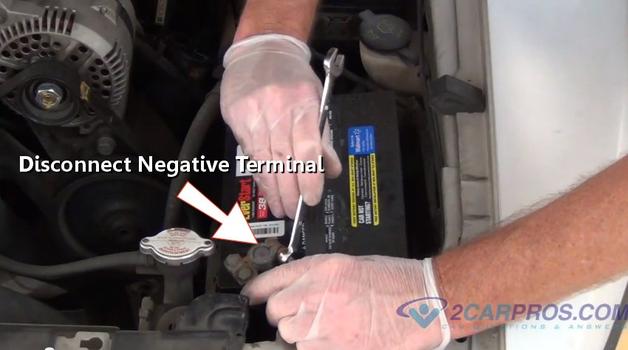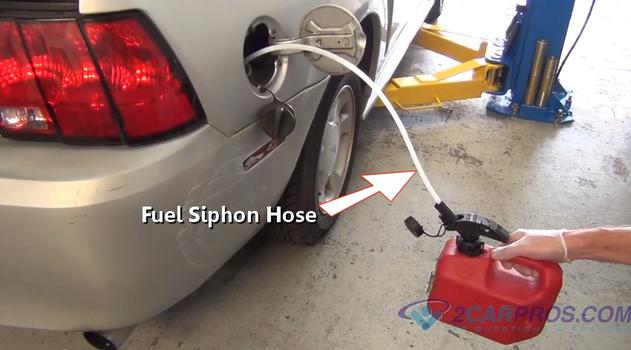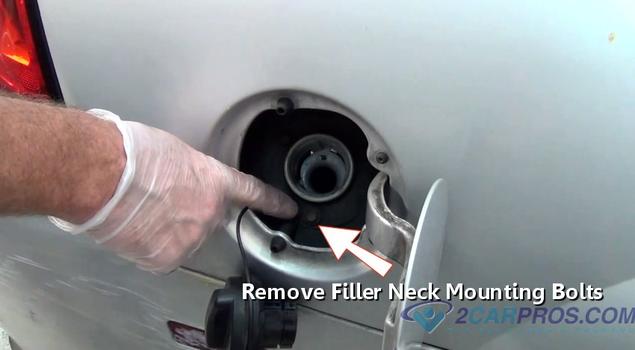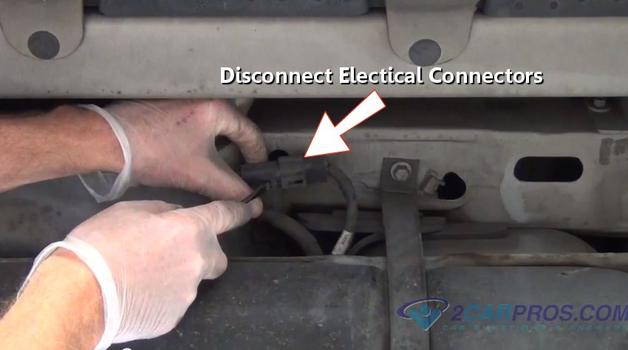How To Replace Vehicle Fuel Pump
Helpful Information
Some manufacturers provide an access door to service the fuel pump, be sure to research this information before beginning. To test for a fuel pump failure a fuel system pressure test
must be performed. Sometimes the the driveshaft must be removed along with the fuel tank.
The automotive engine is designed to operate on a specific fuel system pressure which is vital to engine performance
. To maintain a constant pressure, the fuel pump
is located in the fuel tank and is comprised of an electric motor coupled to a small internal vein style pump. Fuel pumps have a pressure relief valve that allows fuel to bypass while recalculating inside the fuel tank. Direct injection fuel pumps utilize an internal pressure regulator, while having only one liquid fuel line routed to the engine as opposed to two, (pressure and return lines.)
When the ignition key is turned the fuel pump relay engages while supplying electrical power to the pump. This relay is controlled by the main computer
which must detect engine rotation before signaling the relay. When servicing a truck fuel pump there is the option to remove the bed to access the assembly.
Best Practices
- Replace the fuel filter when replacing the pump, debris can be dislodged and enter the fuel filter during a pump failure.
- Have a fire extinguisher available.
- Inspect fuel pump electrical connector for burns or heated spots and replace if damaged. A burned connector can cause the pump to intermittently fail.
- The fuel pump is controlled by a relay, this relay should be tested to ensure proper operation.
- Do not remove tank unless empty or close to empty, a full gas tank is heavy and can cause injury.
Step by step instructions on how to replace an automotive fuel pump. This article pertains to most vehicles except electric.
Difficulty Scale: 4 of 10
Tools and Supplies Needed
- Fuel siphon hose
- Fuel container(s) large enough to hold the amount of gas in the tank.
- Wrench set
- Socket set
- Fuel pump replacement
- Shop towels
- Protective eyewear and clothing
- Fuel filter
- Fuel line removal tool
- Fuel tank support
Begin with the vehicle safety raised in the air enough to access the fuel tank. Use jack stands for additional safety. (No smoking or open flame.)
Step 1 - Disconnect the negative battery terminal, this will avoid sparks while working with a flammable liquid. (Note: Record pre-set radio stations so they can be re-entered when the job is complete.)
 Disconnecting Negative Battery Terminal
Disconnecting Negative Battery Terminal
 Step 2 - After the battery has been disconnected, remove the gas cap and insert a hard plastic line into the filler neck to draw the fuel out. There are a number of methods to perform this by causing a siphon. Once the gas has started flowing keep the container below the level of the tank. (Note: Gasoline and the fumes are highly flammable, so use appropriate precautions.)
Step 2 - After the battery has been disconnected, remove the gas cap and insert a hard plastic line into the filler neck to draw the fuel out. There are a number of methods to perform this by causing a siphon. Once the gas has started flowing keep the container below the level of the tank. (Note: Gasoline and the fumes are highly flammable, so use appropriate precautions.)
Gas Siphon with Gas Can
Step 3 - Locate and remove gas tank filler neck mounting bolts.
 Remove Filler Neck Mounting Bolts
Remove Filler Neck Mounting Bolts
Step 4 - Once the filler neck mounting bolts have been removed, locate and disconnect electrical connectors to fuel tank.
 Disconnect Electrical Connectors
Step 5 - Next, locate and disconnect fuel line using a fuel line removal tool. (Note: Needed for some models such as Ford.) Fuel will leak at this point so be ready to use a fluid catch basin.
Disconnect Electrical Connectors
Step 5 - Next, locate and disconnect fuel line using a fuel line removal tool. (Note: Needed for some models such as Ford.) Fuel will leak at this point so be ready to use a fluid catch basin.
 Disconnection Fuel Lines Using Removal Tool
Disconnection Fuel Lines Using Removal Tool
Step 6 - After liquid fuel lines have been removed, locate and disconnect fuel vapor lines form the fuel tank.
 Removing Fuel Vapor Lines
Removing Fuel Vapor Lines
Step 7 - Some fuel vapor lines are held in place by a retainer clip. Use a small screwdriver to release and remove the clip while removing the line.
 Fuel Line Retainer Clip
Fuel Line Retainer Clip
 Step 8 - Once all fuel lines have been released from the tank, support the tank using a device. This can be done in a number of ways, a fuel tank empty weighs about 30 to 40 pounds.
Step 8 - Once all fuel lines have been released from the tank, support the tank using a device. This can be done in a number of ways, a fuel tank empty weighs about 30 to 40 pounds.
Fuel Tank Support Device
Step 9 - Locate and release tank holder supports, There are two in most cases, at this point the tanks will become loose.
 Release Fuel Tank Supports
Release Fuel Tank Supports
Step 10 - After the tanks mounts have been removed the tank will become loose. Lower the tank and release top mounted fuel lines or electrical connectors if any.
 Removing Fuel Lines and Connectors
Removing Fuel Lines and Connectors
Step 11 - Once the tank has been removed, disconnect fuel lines from the fuel pump.
 Fuel Line Release Tool
Fuel Line Release Tool
Step 12 - Next, remove fuel pump mounting bolts which hold the pump to the fuel tank.
 Removing Fuel Pump Mounting Bolts
Removing Fuel Pump Mounting Bolts
Step 13 - After the mounting bolts have been removed, use a standard screwdriver to gently pry off the fuel pump cover or housing.
 Cover Removed Exposing Fuel Pump
Cover Removed Exposing Fuel Pump
 Step 14 - Next, Release the fuel pump retainer clips if any. Most models are designed with the fuel pump connected to the cover plate.
Step 14 - Next, Release the fuel pump retainer clips if any. Most models are designed with the fuel pump connected to the cover plate.
Releasing Fuel Pump Retainer Clips
Step 15 - Once the fuel pump retainer clip has been released, gently lift the pump from the fuel tank. Most pump units incorporate the fuel level sender as well.
 Fuel Pump Removed
Fuel Pump Removed
Step 16 - After the fuel pump has been removed use a flashlight to inspect the tank for debris and clean as needed. (Note: A small amount of debris is normal.)
 Fuel Tank Inspection
Fuel Tank Inspection
Step 17 - Next, match the failed pump to the replacement pump, make sure all electrical and fuel line connections are the same. Clean mounting surfaces using a shop towel and carburetor cleaner. Gently lower the replacement pump into the fuel tank taking note on fuel level sender orientation.
 Installing New Fuel Pump
Installing New Fuel Pump
Step 18 - Once the pump has been lowered into position press the pump into place. Use any new O ring seals or gaskets provided with the replacement pump.
 New Fuel Pump Installed
New Fuel Pump Installed
Step 19 - After the fuel pump is securely in place, reinstall pump plate mounting bolts.
 Reinstalling Pump Plate Mounting Bolts
Reinstalling Pump Plate Mounting Bolts
 Step 20 - Then, tighten the fuel pump mounting bolts using a star pattern to ensure a proper seal to the fuel tank.
Step 20 - Then, tighten the fuel pump mounting bolts using a star pattern to ensure a proper seal to the fuel tank.
Tighten Fuel Pump Mounting Bolts
After completing these steps, reverse the order to reinstall the tank back into the vehicle. It's best if a new fuel filter is installed at the time of the new fuel pump assembly. Add gas to the fuel tank before turning the ignition key, this will lubricate the pump.

 Step 2 - After the battery has been disconnected, remove the gas cap and insert a hard plastic line into the filler neck to draw the fuel out. There are a number of methods to perform this by causing a siphon. Once the gas has started flowing keep the container below the level of the tank. (Note: Gasoline and the fumes are highly flammable, so use appropriate precautions.)
Step 2 - After the battery has been disconnected, remove the gas cap and insert a hard plastic line into the filler neck to draw the fuel out. There are a number of methods to perform this by causing a siphon. Once the gas has started flowing keep the container below the level of the tank. (Note: Gasoline and the fumes are highly flammable, so use appropriate precautions.)




 Step 8 - Once all fuel lines have been released from the tank, support the tank using a device. This can be done in a number of ways, a fuel tank empty weighs about 30 to 40 pounds.
Step 8 - Once all fuel lines have been released from the tank, support the tank using a device. This can be done in a number of ways, a fuel tank empty weighs about 30 to 40 pounds.




 Step 14 - Next, Release the fuel pump retainer clips if any. Most models are designed with the fuel pump connected to the cover plate.
Step 14 - Next, Release the fuel pump retainer clips if any. Most models are designed with the fuel pump connected to the cover plate.




 Step 20 - Then, tighten the fuel pump mounting bolts using a star pattern to ensure a proper seal to the fuel tank.
Step 20 - Then, tighten the fuel pump mounting bolts using a star pattern to ensure a proper seal to the fuel tank.
Comments
Post a Comment